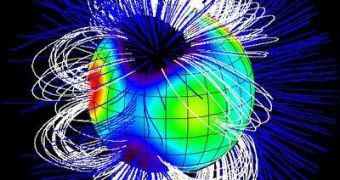The findings, which are contrary to previous studies, suggest that even in its earliest stages, the Earth was already well protected from the solar wind, which can strip away a planet's atmosphere and bathe its surface in lethal radiation.
"The intensity of the ancient magnetic field was very similar to today's intensity. These values suggest the field was surprisingly strong and robust. It's interesting because it could mean the Earth already had a solid iron inner core 3.2 billion years ago, which is at the very limit of what theoretical models of the Earth's formation could predict," said John Tarduno, professor of geophysics in the Department of Earth and Environmental Sciences at the University of Rochester.
For his study, Tarduno isolated individual crystals from a rock, heated them with a laser, and measured their magnetic intensity with a super-sensitive detector called a SQUID-a Superconducting Quantum Interface Device normally used in computing chip design because it's extremely sensitive to the tiniest magnetic fields.
The traditional approach to measuring the ancient Earth's magnetic field was developed more than four decades ago, and involves heating and cooling an igneous rock about an inch across in a chamber that is shielded from magnetic interference. The magnetism is essentially drained from the particles in the rock and then it is refilled while scientists measure how much the particles can hold.
But studies have shown that certain rocks contain tiny crystals like feldspar and quartz-nanometer sized magnetic inclusions that lock in a record of the Earth's magnetic field as they cool from molten magma to hard rock.
As such, to reduce the chance of this contamination, Tarduno picked out the best preserved grains of feldspar and quartz out of 3.2 billion-year-old granite outcroppings in South Africa.
According to him, feldspar and quartz are good preservers of the paleo-magnetic record because their minute magnetic inclusions essentially "take a snapshot of the field as they cool from a molten state".
Tarduno said he wanted to measure the smallest magnetic inclusions because larger magnetic crystals could lose their original magnetic signature at much lower temperatures, meaning they were more likely to suffer magnetic contamination from later warming geological events.
Upon isolating the ideal crystals, Tarduno employed a carbon dioxide laser to heat individual crystals much more quickly than older methods, further lessening the chance of contamination. With the sensitive SQUID, he also measured how much magnetism these individual particles contained.
"The data suggest that the ancient magnetic field strength was at least 50 percent of the present-day field, which typically measures 40 to 60 microteslas. This means that a magnetosphere was definitely present, sheltering the Earth 3.2 billion years ago," said Tarduno.

 14 DAY TRIAL //
14 DAY TRIAL //